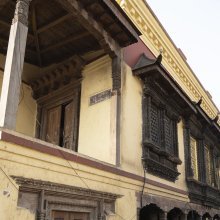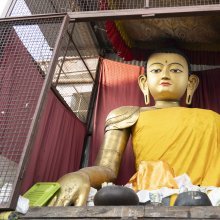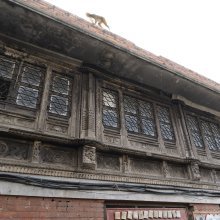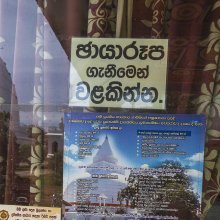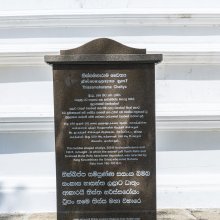Mahavihara, Mahāvihāra: 6 definitions
Introduction:
Mahavihara means something in Buddhism, Pali, Hinduism, Sanskrit, the history of ancient India. If you want to know the exact meaning, history, etymology or English translation of this term then check out the descriptions on this page. Add your comment or reference to a book if you want to contribute to this summary article.
Images (photo gallery)
(+1 more images available)
In Buddhism
Theravada (major branch of Buddhism)
Source: Pali Kanon: Pali Proper NamesMahavihara Mahavihara
The great monastery at Anuradhapura, for many centuries the chief seat of Buddhism in Ceylon. It was founded by Devanampiyatissa, on the counsel of Mahinda, and included the Mahameghavana. The Mahameghavanarama henceforth came to be included in the Mahavihara. The boundary of the vihara was marked out by the king ploughing a circular furrow starting from near the Gangalatittha on the Kadambanadi and ending again at the river (Mhv.xv.188ff.; MT.361; Mbv. 135, 136 says that the ford on the Kadambanadi was Pasanatittha).
A list is given in the Mahabodhivamsa (pp. 135f) of the places through which the sima (boundary) of the Mahavihara passed- Pasanatittha, Kuddavatakapasana, Kumbhakaraavata, the Mahanipa tree, Kakudhapali, Mahaangana tree, Khujjamatula tree, Marutta pokkharani, the northern gate of the Vijayarama park, Gajakumbhakapasana, then passing Avattimajjha, Balakapasana on the Abhayavapi, Mahasusana, Dighapasana, the left side of Candalagama, the Nicasusana to the left of Kammaradeva Simanigrodha, Veluvangana, round the hermitages of the Niganthas Jotiya Giri and Kumbhanda, to the right of the various hermitages of the Paribbajakas, by Hiyagalla, along the shrine of the brahmin Diyavasa, through Telumapali, Talacatukka, to the right of the stables (assamandala), on to Sasakapasana and Marumbatittha. It then proceeded up the river to Sihasinanatittha, on to Pasanatittha, ending at Kuddavatakapasana.
The Mahavihara contained thirty two Malakas (Mhv.xv.214) and had numerous buildings attached to it, apart from sacred shrines, such as the Mahabodhi tree, Thuparama, Maha Thupa, etc. In its early period, the precincts of the Mahavihara contained other buildings besides those dedicated to the service of Buddhism e.g., the hermitages of the Niganthas and the Paribbajakas (as mentioned above) and the shrine of the guardian deity of Anuradhapura (Mhv.xxv.87). In the time of Vattagamani, the Mahavihara monks divided into two factions, and one party occupied Abhayagiri, built by the king (Mhv.xxxiii.97f). At first the differences between these two factions were trivial, but, as time went on, Abhayagiri grew in power and riches and proved a formidable rival to the older monastery.
From time to time various kings and nobles made additions and restorations to the Mahavihara. Thus Vasabha (Mhv.xxxxv.88) built a row of cells, and Bhatikatissa erected a boundary wall (Mhv.xxxvi.2), while Kanitthatissa removed the boundary wall and constructed the Kukkutagiri parivena, twelve large pasadas, a refectory, and a road leading from Mahavihara to Dakkhinavihara (Mhv.xxxvi.10f). Voharikatissa appointed a monthly gift of a thousand to the monks of Mahavihara (Mhv.xxxvi.32), while Sirisanghabodhi built a salaka house (Mhv.xxxvi.74).
Theravāda is a major branch of Buddhism having the the Pali canon (tipitaka) as their canonical literature, which includes the vinaya-pitaka (monastic rules), the sutta-pitaka (Buddhist sermons) and the abhidhamma-pitaka (philosophy and psychology).
India history and geography
Source: archive.org: Ceylon Branch of the Royal Asiatic Society 1963Mahāvihāra is a region in the Southern Area of the city of Anurādhapura.—The Mahāvihāra, also called the Tissārāma (Mahamevnā Tisaramin medieval inscriptions) was founded in B.C. 246 by Devānaṃpiya Tissa and presented to the great Thera, Mahinda. Its territory comprised the Jotivana (previously called Nandana) and Mahāmegha Parks, the area to south and south-east of the citadel.
Source: Cologne Digital Sanskrit Dictionaries: Indian Epigraphical GlossaryMahāvihāra.—(BL), Buddhist convent or monastery. Note: mahāvihāra is defined in the “Indian epigraphical glossary” as it can be found on ancient inscriptions commonly written in Sanskrit, Prakrit or Dravidian languages.

The history of India traces the identification of countries, villages, towns and other regions of India, as well as mythology, zoology, royal dynasties, rulers, tribes, local festivities and traditions and regional languages. Ancient India enjoyed religious freedom and encourages the path of Dharma, a concept common to Buddhism, Hinduism, and Jainism.
Languages of India and abroad
Sanskrit dictionary
Source: Cologne Digital Sanskrit Dictionaries: Monier-Williams Sanskrit-English Dictionary1) Mahāvihāra (महाविहार):—[=mahā-vihāra] [from mahā > mah] m. a gr° Buddhist monastery, [Buddhist literature]
2) [v.s. ...] Name of a Bud° mon° in Ceylon, [ib.]
[Sanskrit to German]
Sanskrit, also spelled संस्कृतम् (saṃskṛtam), is an ancient language of India commonly seen as the grandmother of the Indo-European language family (even English!). Closely allied with Prakrit and Pali, Sanskrit is more exhaustive in both grammar and terms and has the most extensive collection of literature in the world, greatly surpassing its sister-languages Greek and Latin.
See also (Relevant definitions)
Partial matches: Maha, Vihara.
Starts with: Mahavihara-ayatana, Mahavihara-svamin, Mahaviharavasin, Mahaviharavasinah.
Ends with: Asanalokeshvaramahavihara, Bandhudattamahavihara, Cakravarnamahavihara, Dattamahavihara, Hiranyavarnamahavihara, Jayamanoharavarnamahavihara, Jyotirmahavihara, Kacchapalagirimahavihara, Manipurajaivamahavihara, Mayuravarnamahavihara, Nilavijita-mahavihara, Padmacakramahavihara, Paravatamahavihara, Rajamahavihara, Rudravarnamahavihara, Tissamahavihara, Unkulimahavihara.
Full-text (+176): Odantapuri, Abhayagiri, Mahalekhapabbata, Uddandapura, Samuddagiri-parivena, Bahalamassu Tissa, Mahaviharavasin, Sanghasema, Odantapura, Gajakumbhakapasana, Maha Angana, Kalakacchagama, Gangalatittha, Kuntamalaka, Diyavasa, Talacatukka, Kukkutagiri Parivena, Telumapali, Mahavihara-ayatana, Piyanga Parivena.
Relevant text
Search found 24 books and stories containing Mahavihara, Mahāvihāra, Maha-vihara, Mahā-vihāra; (plurals include: Mahaviharas, Mahāvihāras, viharas, vihāras). You can also click to the full overview containing English textual excerpts. Below are direct links for the most relevant articles:
Dipavamsa (study) (by Sibani Barman)
Mahavamsa (by Wilhelm Geiger)
Stupas in Orissa (Study) (by Meenakshi Chauley)
During the Somavamsis’s reign < [Chapter 2]
Formal Education System in Ancient India (by Sushmita Nath)
The Odantapurī university < [Chapter 3 - Centres of Learning in Vedic and Buddhist Period]
The Buddhist Vihāra or Monastery < [Chapter 3 - Centres of Learning in Vedic and Buddhist Period]
A Short history of Lanka (by Humphry William Codrington)
Settlement in Early Historic Ganga Plain (by Chirantani Das)
Part 7 - Nalanda’s Rise of a Multi-functional Nodal Centre < [Chapter III - Nālandā: Evidence for rise and progress of the settlement]
